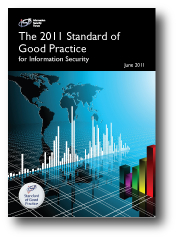Top Qs
Timeline
Chat
Perspective
Standard of Good Practice for Information Security
From Wikipedia, the free encyclopedia
Remove ads
The Standard of Good Practice for Information Security (SOGP), published by the Information Security Forum (ISF), is a business-focused, practical and comprehensive guide to identifying and managing information security risks in organizations and their supply chains.[1]
This article has multiple issues. Please help improve it or discuss these issues on the talk page. (Learn how and when to remove these messages)
|

The most recent edition is 2024,[2] an update of the 2022 edition. The 2024 edition is the first that will have incremental updates via the ISF Live website, ahead of its biennial refresh due in 2026.
Upon release, the 2011 Standard was the most significant update of the standard for four years. It covers information security 'hot topics' such as consumer devices, critical infrastructure, cybercrime attacks, office equipment, spreadsheets and databases and cloud computing.
The Standard is aligned with the requirements for an Information Security Management System (ISMS) set out in ISO/IEC 27000-series standards, and provides wider and deeper coverage of ISO/IEC 27002 control topics, as well as cloud computing, information leakage, consumer devices and security governance.
In addition to providing a tool to enable ISO 27001 certification, the Standard provides alignment matrices to with other relevant standards and legislation such as PCI DSS and the NIST Cyber Security Framework, to enable compliance with these standards too.
The Standard is used by Chief Information Security Officers (CISOs), information security managers, business managers, IT managers, internal and external auditors, IT service providers in organizations of all sizes.
The Standard is available free of charge to members of the ISF. Non-members are able to purchase a copy of the standard directly from the ISF.
Remove ads
Organization
Summarize
Perspective
The Standard has historically been organized into six categories, or aspects. Computer Installations and Networks address the underlying IT infrastructure on which Critical Business Applications run. The End-User Environment covers the arrangements associated with protecting corporate and workstation applications at the endpoint in use by individuals. Systems Development deals with how new applications and systems are created, and Security Management addresses high-level direction and control.
The Standard is now primarily published in a simple "modular" format that eliminates redundancy. For example, the various sections devoted to security audit and review have been consolidated.
The six aspects within the Standard are composed of a number of areas, each covering a specific topic. An area is broken down further into sections, each of which contains detailed specifications of information security best practice. Each statement has a unique reference. For example, SM41.2 indicates that a specification is in the Security Management aspect, area 4, section 1, and is listed as specification No. 2 within that section.
The Principles and Objectives part of the Standard provides a high-level version of the Standard, by bringing together just the principles (which provide an overview of what needs to be performed to meet the Standard) and objectives (which outline the reason why these actions are necessary) for each section.
The published Standard also includes an extensive topics matrix, index, introductory material, background information, suggestions for implementation, and other information.
Remove ads
See also
See Category:Computer security for a list of all computing and information-security related articles.
References
External links
Wikiwand - on
Seamless Wikipedia browsing. On steroids.
Remove ads
